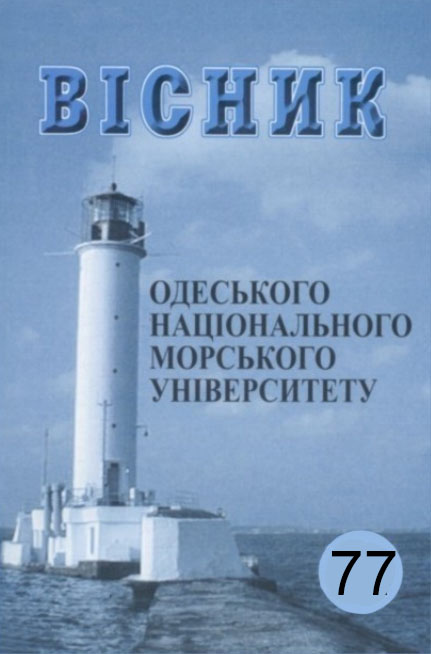Mathematical model of optimal scenario selection of ship operations based on a risk-oriented network criterion
Main Article Content
Abstract
The article develops a formalized model for choosing the optimal scenario for performing ship operations, taking into account the risk-oriented structure of the criteria. The methodology involves constructing a network relationship between performance criteria and risk factors that impact shipping safety. The possibility of aggregation of integral risk using the weight matrix and the function of adjusted utility with the risk-aversion parameter is considered. The model was tested on the example of a navigation transition with route alternatives, taking into account changes in weather conditions and the level of operational reliability. A scenario analysis was carried out using sensitivity methods, which made it possible to identify the influence of key factors on decision-making. The proposed approach can be integrated into the decision support system (DSS) of industry enterprises to increase the level of validity and adaptability of management decisions in conditions of uncertainty and risk. In particular, this method allows you to evaluate potential scenarios of further actions based on accumulated experience, and automatically form strategic priorities taking into account changes in the external environment. In addition, to quickly adapt operational processes, which is especially relevant for shipping companies operating in conditions of limited resources, regulatory pressure, and growing requirements for the safety and sustainability of enterprises.
Article Details
References
2. Melnyk, O. (2023). Analysis and assessment of ship safety using a multilayer model. Bulletin of Odessa National Maritime University, (70), 34-46. https://doi.org/10.47049/2226-1893-2023-3-34-46
3. Wang, N., Yuen, K. F., Yuan, J., & Li, D. (2024). Ship collision risk assessment: A multi-criteria decision-making framework based on Dempster- Shafer evidence theory. Applied Soft Computing, 162, 111823. https://doi.org/10.1016/j.asoc.2024.111823
4. Pan, W., Wang, Y., Xie, X., Li, M., & Fan, J. (2024). Ship Collision Risk Assessment Algorithm Based on the Especial Cautious Navigation Angle Model. Journal of Marine Science and Engineering, 13(1), 173. https://doi.org/10.3390/jmse13010173
5. Huang, J., & Ung, S. (2023). Risk Assessment and Traffic Behaviour Evaluation of Ships. Journal of Marine Science and Engineering, 11 (12), 2297. https://doi.org/10.3390/jmse11122297
6. Chen, C., Zhang, X., Wang, G., Feng, F., Sun, C., & He, Q. (2023). A hybrid multi-criteria decision-making framework for ship-equipment suitability evaluation using improved ISM, AHP, and fuzzy TOPSIS methods. Journal of Marine Science and Engineering, 11(3), 607. https://doi.org/10.3390/jmse11030607
7. Li, X., Oh, P., Zhou, Y., & Yuen, K. F. (2023). Operational risk identification of maritime surface autonomous ship: A network analysis approach. Transport Policy, 130, 1-14. https://doi.org/10.1016/j.tranpol.2022.10.012
8. Sur, J.-M., & Kim, Y.-J. (2024). Multi-criteria model for identifying and ranking risky types of maritime accidents using integrated ordinal priority approach and grey relational analysis approach. Sustainability, 16(14), 6023. https://doi.org/10.3390/su16146023
9. Xu, M., Ma, X., Zhao, Y., & Qiao, W. (2023). A systematic literature review of maritime transportation safety management. Journal of Marine Science and Engineering, 11(12), 2311. https://doi.org/10.3390/jmse11122311
10. Li, X., Zhang, X., & Yuan, Y. (2024). Dynamic multi-attribute deci- sion-making method for risk-based ship design. Applied Sciences, 14 (13), 5387. https://doi.org/10.3390/app14135387
11. Ahmed, S., Li, T., Huang, S., & Cao, J. (2023). Dynamic and quantitative risk assessment of cruise ship pod propulsion system failure: An integrated Type-2 fuzzy-Bayesian approach. Ocean Engineering, 279, 114601. https://doi.org/10.1016/j.oceaneng.2023.114601
12. Basnet, S., BahooToroody, A., Montewka, J., Chaal, M., & Valdez Banda, O.A. (2023). Selecting cost-effective risk control option for advanced maritime operations: Integration of STPA-BN-influence diagram. Ocean Engineering, 280, 114631. https://doi.org/10.1016/j.oceaneng.2023.114631
13. Xiao, F., Ma, Y., & Wu, B. (2021). Review of Probabilistic Risk Assessment Models for Ship Collisions with Structures. Applied Sciences, 12(7), 3441. https://doi.org/10.3390/app12073441
14. Zhang, W., & Zhang, Y. (2023). Navigation risk assessment of autonomous ships based on entropy-TOPSIS-coupling coordination model. Journal of Marine Science and Engineering, 11(2), 422. https://doi.org/10.3390/jmse11020422
15. Kim, Y., Kim, J., Lee, W., Park, H., & Cho, D. J. (2025). FURIOUS: Fully unified risk-assessment with interactive operational user system for vessels. PLOS ONE, 20(5), e0323300. https://doi.org/10.1371/journal.pone.0323300
16. Latinopoulos, C., Zavvos, E., Kaklis, D., Leemen, V., & Halatsis, A. (2025). Marine voyage optimization and weather routing with deep reinforcement learning. Journal of Marine Science and Engineering, 13(5), 902. https://doi.org/10.3390/jmse13050902
17. Zhou, Y., Liu, Z., Wang, X., Xie, H., Tao, J., Wang, J., & Yang, Z. (2024). Human errors analysis for remotely controlled ships during collision avoidance. Frontiers in Marine Science, 11, 1473367. https://doi.org/10.3389/fmars.2024.1473367
18. Shi, J., Liu, Z., Feng, Y., Wang, X., Zhu, H., Yang, Z., Wang, J., & Wang, H. (2024). Evolutionary model and risk analysis of ship collision accidents based on complex networks and DEMATEL. Ocean Engineering, 305, 117965. https://doi.org/10.1016/j.oceaneng.2024.117965
19. Liu, T., Xu, X., Lei, Z., Zhang, X., Sha, M., & Wang, F. (2023). A multi-task deep learning model integrating ship trajectory and collision risk prediction. Ocean Engineering, 287, 115870. https://doi.org/10.1016/j.oceaneng.2023.115870
20. Melnyk, O., Onyshchenko, S., Onishchenko, O., Shumylo, O., Voloshyn, A., Koskina, Y., & Volianska, Y. (2022). Review of ship information security risks and safety of maritime transportation issues. TransNav: International Journal on Marine Navigation and Safety of Sea Transportation, 16(4), 717- 722. https://doi.org/10.12716/1001.16.04.13
21. Melnyk, O., Onishchenko, O., Onyshchenko, S., Golikov, V., Sapiha, V., Shcherbina, O., & Andrievska, V. (2022). Study of environmental efficiency of ship operation in terms of freight transportation effectiveness provision. TransNav, 16(4), 723-729. https://doi.org/10.12716/1001.16.04.14
22. Melnyk, O., Onyshchenko, S., Onishchenko, O., Lohinov, O., & Oche- retna, V. (2023). Integral approach to vulnerability assessment of ship’s critical equipment and systems. Transactions on Maritime Science, 12(1), 25-37. https://doi.org/10.7225/toms.v12.n01.002
23. Onyshchenko, S., Bychkovsky, Y., Melnyk, O., Onishchenko, O., Jurko- vič, M., Rubskyi, V., & Liashenko, K. (2024). A model for assessing shipping safety within project-orientated risk management based on human element. Scientific Journal of the Silesian University of Technology. Series Transport, 123, 319-334. https://doi.org/10.20858/sjsutst.2024.123.16
